Groundhog
The groundhog (Marmota monax), also known as a woodchuck, is a rodent of the family Sciuridae, belonging to the group of large ground squirrels known as marmots.[2] It was first scientifically described by Carl Linnaeus in 1758.[3]
| Groundhog | |
|---|---|
 | |
| at Laval University campus, Quebec, Canada | |
| Scientific classification | |
| Kingdom: | Animalia |
| Phylum: | Chordata |
| Class: | Mammalia |
| Order: | Rodentia |
| Family: | Sciuridae |
| Genus: | Marmota |
| Species: | M. monax |
| Binomial name | |
| Marmota monax | |
| Subspecies | |
| |
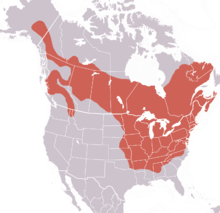 | |
| Groundhog range | |
| Synonyms | |
|
Mus monax Linnaeus, 1758 | |
The groundhog is also referred to as a chuck, wood-shock, groundpig, whistlepig,[4][5] whistler, thickwood badger, Canada marmot, monax, moonack, weenusk, red monk[6] and, among French Canadians in eastern Canada, siffleux.[7]
The name "thickwood badger" was given in the Northwest to distinguish the animal from the prairie badger. Monax (Móonack) is an Algonquian name of the woodchuck, which meant "digger" (cf. Lenape monachgeu).[8][9] Young groundhogs may be called chucklings.[10]:66
Other marmots, such as the yellow-bellied and hoary marmots, live in rocky and mountainous areas, but the groundhog is a lowland creature. It is found through much of the eastern United States across Canada and into Alaska.[11]
Description
The groundhog is by far the largest sciurid in its geographical range, excepting British Columbia where its range may abut that of its somewhat larger cousin, the hoary marmot. Adults may measure from 41.8 to 68.5 cm (16.5 to 27.0 in) in total length including a tail of 9.5 to 18.7 cm (3.7 to 7.4 in).[12][13][14] Weights of adult groundhogs, typically at least, fall between 2 and 6.3 kg (4.4 and 13.9 lb).[14][15][16]
Male groundhogs average slightly larger than females and, like all marmots, they are considerably heavier during autumn (when engaged in autumn hyperphagia) than when emerging from hibernation in spring. Adult males average year-around weight 3.83 kg (8.4 lb), with spring to fall average weights of 3.1 to 5.07 kg (6.8 to 11.2 lb) while females average 3.53 kg (7.8 lb), with spring to fall averages of 3.08 to 4.8 kg (6.8 to 10.6 lb).[12][17] Seasonal weight changes indicate circannual deposition and use of fat. Groundhogs attain progressively higher weights each year for the first two or three years, after which weight plateaus.[12]
Groundhogs have four incisor teeth which grow 1.5 mm (1⁄16 inch) per week. Constant usage wears them down again by about that much each week.[18] Unlike the incisors of many other rodents, the incisors of groundhogs are white to ivory-white.[19][20] Groundhogs are well-adapted for digging, with short, powerful limbs and curved, thick claws. Unlike other sciurids, the groundhog's tail is comparably shorter—only about one-fourth of body length.
Etymology
The etymology of the name woodchuck is unrelated to wood or chucking. It stems from an Algonquian (possibly Narragansett) name for the animal, wuchak.[21] The similarity between the words has led to the popular tongue-twister:
- How much wood would a woodchuck chuck
- if a woodchuck could chuck wood?
- A woodchuck would chuck all the wood he could
- if a woodchuck could chuck wood![22]
Distribution and habitat
The groundhog prefers open country and the edges of woodland, and is rarely far from a burrow entrance.[23] Marmota monax has a wide geographic range. It is typically found in low-elevation forests, small woodlots, fields, pastures and hedgerows. It constructs dens in well-drained soil, and most have summer and winter dens. Human activity has increased food access and abundance allowing M. monax to thrive.[24]
Survival
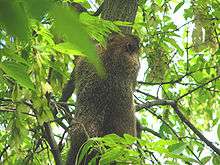
In the wild, groundhogs can live up to six years with two or three being average. In captivity, groundhogs reportedly live up to 14 years. Human development, which often produces openings juxtaposed with second growth trees that are incidentally also favored by groundhogs, often ensures that groundhogs in well-developed areas are nearly free of predators, beyond humans (through various forms of pest control or roadkills) or mid-to-large sized dogs.[25]
Wild predators of adult groundhogs in most of eastern North America include coyotes, badgers[26], bobcats and foxes (largely only red fox). Many of these predators are successful stealth stalkers so can catch groundhogs by surprise before the large rodents can escape to their burrows; badgers likely hunt them by digging them out from their burrows. Coyotes in particular are sizable enough to overpower any groundhog, with the latter being the third most significant prey species per a statewide study in Pennsylvania.[27][28][29][30][31][32]
Large predators such as gray wolf and eastern cougar are basically extirpated in the east but still may hunt groundhogs on occasion in Canada.[33][34] Golden eagles can also prey on adult groundhogs but seldom occurs in the range of this marmot as can reportedly great horned owls, but this owl rarely does especially given the temporal differences of its nocturnal habits.[35][36]
Young groundhogs (usually those less than a couple months) may also be taken by American mink, perhaps other smallish mustelids, cats, timber rattlesnakes and hawks, though red-tailed hawks can take groundhogs at least of up to the size of yearling juveniles and northern goshawks can take up to perhaps weak emergent adult groundhogs in spring.[12][14][37][38][39]
Groundhogs, beyond their large size have several successful anti-predator behaviors, usually retreating to the safety of their burrow which most predators will not attempt to enter but will readily fight off any of those who press the attack with their sharp claws and large incisors. They can also scale trees to escape a threat.[40][41]
Occasionally woodchucks may suffer from parasitism and a woodchuck may die from infestation or from bacteria transmitted by vectors.[42] In areas of intensive agriculture and dairying regions of the state of Wisconsin, particularly the southern parts, the woodchuck by 1950 had been almost extirpated.[43]:124 Jackson (1961) suggested the amount of damage done by the woodchuck had been exaggerated and that excessive persecution by people substantially reduced its numbers in Wisconsin.
In some areas marmots are important game animals and are killed regularly for sport, food, or fur. In Kentucky an estimated 267,500 M. monax were taken annually from 1964 to 1971 (Barbour and Davis 1974)[44] Woodchucks had protected status in the state of Wisconsin[45] until 2017.[46] Woodchuck numbers appear to have decreased in Illinois.[47]
Behavior
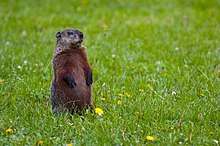
The time spent observing groundhogs by field biologists represents only a small fraction of time devoted to the field research.[48] W.J. Schoonmaker reports that groundhogs may hide when they see, smell or hear the observer.[10]:41–43 Ken Armitage, marmot researcher, states that the social biology of the groundhog is poorly studied.[49] Despite their heavy-bodied appearance, groundhogs are accomplished swimmers and occasionally climb trees when escaping predators or when they want to survey their surroundings.[50] They prefer to retreat to their burrows when threatened; if the burrow is invaded, the groundhog tenaciously defends itself with its two large incisors and front claws. Groundhogs are generally agonistic and territorial among their own species and may skirmish to establish dominance.[51] Outside their burrow, individuals are alert when not actively feeding. It is common to see one or more nearly-motionless individuals standing erect on their hind feet watching for danger. When alarmed, they use a high-pitched whistle to warn the rest of the colony, hence the name "whistle-pig".[52][53] Groundhogs may squeal when fighting, seriously injured, or caught by a predator.[53] Other sounds groundhogs may make are low barks and a sound produced by grinding their teeth.[53] David P. Barash wrote he witnessed only two occasions of upright play-fighting among woodchucks and that the upright posture of play-fighting involves sustained physical contact between individuals and may require a degree of social tolerance virtually unknown in M. monax. He said it was possible to conclude, alternatively, that upright play-fighting is part of the woodchuck's behavioral repertory but rarely shown because of physical spacing and/or low social tolerance.[54]
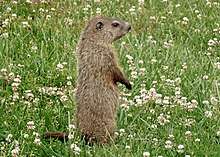
Diet
Mostly herbivorous, groundhogs eat primarily wild grasses and other vegetation, including berries and agricultural crops, when available.[51] In early spring, dandelion and coltsfoot are important groundhog food items. Some additional foods include sheep sorrel, timothy-grass, buttercup, tearthumb, agrimony, red and black raspberries, mulberries, buckwheat, plantain, wild lettuce, all varieties of clover, and alfalfa.[55] Groundhogs also occasionally eat grubs, grasshoppers, insects, snails and other small animals, but are not as omnivorous as many other Sciuridae.
Groundhogs will occasionally eat baby birds they come upon by accident.[56] An adult groundhog can eat more than a pound of vegetation daily.[57] In early June, woodchucks' metabolism slows, and while their food intake decreases, their weight increases by as much as 100% as they produce fat deposits to sustain them during hibernation and late winter.[58] Instead of storing food, groundhogs stuff themselves to survive the winter without eating.[59] Thought not to drink water, groundhogs are reported to obtain needed liquids from the juices of food-plants, aided by their sprinkling with rain or dew.[60][61][62]
Burrows
Groundhogs are excellent burrowers, using burrows for sleeping, rearing young, and hibernating. W. J. Schoonmaker excavated 11 dens finding the earth removed from these averaged six cubic feet or four and eight-tenths bushels per den. The longest burrow was 24 feet plus 2 short side galleries. The amount of soil taken from this den was eight bushels and it weighed 640 pounds. The average weight of the earth taken from all eleven dens was 384 pounds.[63] Though groundhogs are the most solitary of the marmots, several individuals may occupy the same burrow. Groundhog burrows usually have two to five entrances, providing groundhogs their primary means of escape from predators. Burrows can pose a serious threat to agricultural and residential development by damaging farm machinery and even undermining building foundations.[52] In a June 7, 2009 Humane Society of the United States article, "How to Humanely Chuck a Woodchuck Out of Your Yard", John Griffin, director of Humane Wildlife Services, stated you would have to have a lot of woodchucks working over a lot of years to create tunnel systems that would pose any risk to a structure.
The burrow is used for safety, retreat in bad weather, hibernating, sleeping, love nest, and nursery. In addition to the nest, there is an excrement chamber. The nest chamber may be about twenty inches to three feet below ground surface. It is about sixteen inches wide and fourteen inches high. There are typically two burrow openings or holes. One is the main entrance, the other a spy hole. Description of the length of the burrow often includes side galleries. Excluding side galleries, Schoonmaker reports the longest was twenty-four feet, and the average length of eleven dens was fourteen feet.[64] W. H. Fisher investigated nine burrows, finding the deepest point forty-nine inches down. The longest, including side galleries, was forty-seven feet, eleven and one half inches.[65] Numbers of burrows per individual groundhog decreases with urbanization.[66][67]
Bachman mentioned that when the young groundhogs are a few months old, they prepare for separation, digging a number of holes in the area of their early home. Some of these holes were only a few feet deep and never occupied but the numerous burrows gave the impression that groundhogs live in communities.[68]
Hibernation
Groundhogs are one of the few species that enter into true hibernation, and often build a separate "winter burrow" for this purpose. This burrow is usually in a wooded or brushy area and is dug below the frost line and remains at a stable temperature well above freezing during the winter months. In most areas, groundhogs hibernate from October to March or April, but in more temperate areas, they may hibernate as little as three months.[69] Groundhogs hibernate longer in northern latitudes than southern latitudes.[70][71] To survive the winter, they are at their maximum weight shortly before entering hibernation.[72] When the groundhog enters hibernation, there is a drop in body temperature to as low as 35 degrees Fahrenheit, heart rate falls to 4–10 beats per minute and breathing rate falls to one breath every six minutes.[73] During hibernation, they experience periods of torpor and arousal.[74] Hibernating woodchucks lose as much as half their body weight by February.[75] They emerge from hibernation with some remaining body fat to live on until the warmer spring weather produces abundant plant materials for food.[72] Males emerge from hibernation before females.[76][77] Groundhogs are mostly diurnal, and are often active early in the morning or late afternoon.[78]
Reproduction
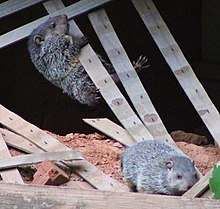
Usually groundhogs breed in their second year, but a small proportion may breed in their first. The breeding season extends from early March to mid- or late April, after hibernation. A mated pair remains in the same den throughout the 31- to 32-day[79] gestation period. As birth of the young approaches in April or May, the male leaves the den. One litter is produced annually, usually containing two to six blind, hairless and helpless young. Groundhog mothers introduce their young to the wild once their fur is grown in and they can see. At this time, if at all, the father groundhog comes back to the family.[80]:316 By the end of August, the family breaks up; or at least, the larger number scatter, to burrow on their own.[81]
Relationship with humans
Both their diet and habit of burrowing make them serious nuisance animals around farms and gardens. They will eat many commonly grown vegetables, and their burrows can destroy farm ponds and undermine foundations.
Very often the dens of groundhogs provide homes for other animals including skunks, red foxes, and cottontail rabbits. The fox and skunk feed upon field mice, grasshoppers, beetles and other creatures that destroy farm crops. In aiding these animals, the groundhog indirectly helps the farmer. In addition to providing homes for itself and other animals, the groundhog aids in soil improvement by bringing subsoil to the surface. The groundhog is also a valuable game animal and is considered a difficult sport when hunted in a fair manner.[82] In some parts of the U.S., they have been eaten.[83]
A report in 1883 by the New Hampshire Legislative Woodchuck Committee humorously describes the groundhog's objectionable character:[84]
The woodchuck, despite its deformities both of mind and body, possesses some of the amenities of a higher civilization. It cleans its face after the manner of the squirrels, and licks its fur after the manner of a cat. Your committee is too wise, however, to be deceived by this purely superficial observation of better habits. Contemporaneous with the ark, the woodchuck has not made any material progress in social science, and it is now too late to reform the wayward sinner. The average age of the woodchuck is too long to please your committee.... The woodchuck is not only a nuisance, but also a bore. It burrows beneath the soil, and then chuckles to see a mowing machine, man and all, slump into one of these holes and disappear....
The committee concludes that "a small bounty will prove of incalculable good; at all events, even as an experiment, it is certainly worth trying; therefore your committee would respectfully recommend that the accompanying bill be passed."[85]
Groundhogs may be raised in captivity, but their aggressive nature can pose problems. Doug Schwartz, a zookeeper and groundhog trainer at the Staten Island Zoo, has been quoted as saying "They’re known for their aggression, so you’re starting from a hard place. His natural impulse is to kill ’em all and let God sort ’em out. You have to work to produce the sweet and cuddly."[86] Groundhogs cared for in wildlife rehabilitation that survive but cannot be returned to the wild may remain with their caregivers and become educational ambassadors.[87][88][89]
In the United States and Canada, the yearly February 2 Groundhog Day celebration has given the groundhog recognition and popularity. The most popularly known of these groundhogs are Punxsutawney Phil, Wiarton Willie, Jimmy the Groundhog, Dunkirk Dave, and Staten Island Chuck kept as part of Groundhog Day festivities in Punxsutawney, Pennsylvania; Wiarton, Ontario; Sun Prairie, Wisconsin; Dunkirk, New York; and Staten Island respectively. The 1993 comedy film Groundhog Day references several events related to Groundhog Day, and portrays both Punxsutawney Phil himself, and the annual Groundhog Day ceremony. Famous Southern groundhogs include General Beauregard Lee, based at the Dauset Trails Nature Center outside Atlanta, Georgia.[90]
Groundhogs are used in medical research on hepatitis B-induced liver cancer. A percentage of the woodchuck population is infected with the woodchuck hepatitis virus (WHV), similar to human hepatitis B virus. Humans do not receive hepatitis from woodchucks with WHV but the virus and its effects on the liver make the woodchuck the best available animal for the study of viral hepatitis in humans. The only other animal model for hepatitis B virus studies is the chimpanzee, an endangered species.[91] Woodchucks are also used in biomedical research investigating metabolic function, obesity, energy balance, the endocrine system, reproduction, neurology, cardiovascular disease, cerebrovascular disease, and neoplastic disease.[92] Researching the hibernation patterns of groundhogs may lead to benefits for humans, including lowering of the heart rate in complicated surgical procedures. [93]
Groundhog burrows have revealed at least two archaeological sites, the Ufferman Site in the U.S. state of Ohio[94] and Meadowcroft Rockshelter in Pennsylvania. Archaeologists have never excavated the Ufferman Site, but the activities of local groundhogs have revealed numerous artifacts. They favor the loose soil of the esker at the site lies, and their burrow digging has brought many objects to the surface: human and animal bones, pottery, and bits of stone.[94] Woodchuck remains were found in the Indian mounds at Aztalan, Jefferson County, Wisconsin.[95]
Robert Frost's poem "A Drumlin Woodchuck" uses the imagery of a groundhog dug into a small ridge as a metaphor for his emotional reticence.[96]
References
- Linzey, A. V.; Hammerson, G. (NatureServe) & Cannings, S. (NatureServe) (2008). "Marmota monax". IUCN Red List of Threatened Species. 2008. Retrieved 7 January 2015.CS1 maint: ref=harv (link)
- Thorington, R.W., Jr.; Hoffman, R.S. (2005). "Family Sciuridae". In Wilson, D.E.; Reeder, D.M (eds.). Mammal Species of the World: A Taxonomic and Geographic Reference (3rd ed.). Johns Hopkins University Press. p. 802. ISBN 978-0-8018-8221-0. OCLC 62265494.
- Linné, Carl von (1758). Systema naturae per regna tria naturae. 1 (10 ed.). p. 60 – via Biodiversity Heritage Library.
- "Marmota monax". North American Mammals. Smithsonian Institution. Retrieved 1 February 2015.
- Seton, Ernest Thompson Lives of Game Animals, Volume IV, p. 300
- Seton, Ernest Thompson, Lives of Game Animals, Volume IV, p. 300
- Canadian Wildlife Federation - Faune et flore du pays - La marmotte commune
- Chamberlain, Alexander F. (22 November 2018). "Algonkian Words in American English: A Study in the Contact of the White Man and the Indian". The Journal of American Folklore. 15 (59): 240–267. doi:10.2307/533199. JSTOR 533199.
- Seton, Ernest Thompson, Lives of Game Animals. pp. 300–301
- Schoonmaker, W.J. (1966). The World of the Woodchuck. J.B. Lippincott. ISBN 978-1135544836.
- Smithsonian National Museum of Natural History, North American Mammals, Marmota monax, Woodchuck,
- Kwiecinski, G. G. (1998). Marmota monax. Mammalian Species, (591), 1-8.
- Schwartz, C. W., & Schwartz, E. R. (2001). The wild mammals of Missouri. University of Missouri Press.
- Wildlife of Virginia and Maryland and Washington, D.C. 2003, Charles Fergus, p. 45, ISBN 978-0811728218
- Ferron, J., & Ouellet, J. P. (1991). Physical and behavioral postnatal development of woodchucks (Marmota monax). Canadian Journal of Zoology, 69(4), 1040-1047.
- Couser, W., Sargent, P., Brownhill, L. E., & Benirschke, K. (1963). The somatic chromosomes of the Northeastern American woodchuck, Marmota monax. Cytologia, 28(1), 108-111.
- North Carolina Wild, Wildlife Profiles, Woodchuck, Marmota monax
- Leon M. Lederman Science Education Center, Fermilab Flora and Fauna Virtual Exhibit, Woodchuck
- Ohio DNR, ODNR Division of WILDLIFE, Woodchuck (Groundhog) -Marmota monax
- Schoonmaker, W.J.,(1966) The World of the Woodchuck, p. 20
- Marmota monax: Woodchuck. animaldiversity.com. Retrieved on 2015-02-24.
- Lyrics and Words for Children's Nursery Rhymes and Songs. BusSongs.com. Retrieved on 2011-09-15.
- Grizzell, Roy A. (April 1955). "A Study of the Southern Woodchuck, Marmota monax monax". American Midland Naturalist. 53 (2): 257. doi:10.2307/2422068. JSTOR 2422068.
- "Marmota monax (woodchuck)". Animal Diversity Web.
- Lehrer, E. W., Schooley, R. L., & Whittington, J. K. (2011). Survival and antipredator behavior of woodchucks (Marmota monax) along an urban–agricultural gradient. Canadian Journal of Zoology, 90(1), 12-21.
- "Badger Biology (Ontario Badgers)". www.ontariobadgers.org. Retrieved 2019-07-22.
- Witmer, G. W., Pipas, M. J., & Hayden, A. (1995). Some observations on coyote food habits in Pennsylvania. Journal of the Pennsylvania Academy of Science, 77-80.
- Gipson, P. S. (1974). Food habits of coyotes in Arkansas. The Journal of Wildlife Management, 848-853.
- Progulske, D. R. (1955). Game animals utilized as food by the bobcat in the southern Appalachians. The Journal of Wildlife Management, 19(2), 249-253.
- Rose, C., & Prange, S. (2015). Diet of the recovering Ohio bobcat (Lynx rufus) with a consideration of two subpopulations. The American Midland Naturalist, 173(2), 305-318.
- Hockman, J. G., & Chapman, J. A. (1983). Comparative feeding habits of red foxes (Vulpes vulpes) and gray foxes (Urocyon cinereoargenteus) in Maryland. American Midland Naturalist, 276-285.
- Wildlife of Pennsylvania, Charles Fergus, Amelia Hansen, p. 43, ISBN 978-0811728997
- Voigt, D. R., Kolenosky, G. B., & Pimlott, D. H. (1976). Changes in summer foods of wolves in central Ontario. The Journal of Wildlife Management, 663-668.
- Bolgiano, C., & Roberts, J. (Eds.). (2005). The Eastern Cougar: Historic Accounts, Scientific Investigations, and New Evidence. Stackpole Books.
- Olendorff, R. R. (1976). The food habits of North American golden eagles. American Midland Naturalist, 231-236.
- Bent, A. C. 1938. Life histories of North American birds of prey, Part 2. U.S. National Museum Bulletin 170:295-357.
- Becker, T. E.; Smith, D. G.; Bosakowski, T. (2006). Habitat, food habits, and productivity of northern goshawks nesting in Connecticut. Studies in Avian Biology. 31: 119–125.
- Aschemeier, L. M., & Maher, C. R. (2011). "Eavesdropping of woodchucks (Marmota monax) and eastern chipmunks (Tamias striatus) on heterospecific alarm calls". Journal of Mammalogy. 92 (3): 493–499. doi:10.1644/09-MAMM-A-322.1.CS1 maint: multiple names: authors list (link)
- George, W. G. (1974). Domestic cats as predators and factors in winter shortages of raptor prey. The Wilson Bulletin, 384-396.
- Beer, Encyclopedia of North American Mammals: An Essential Guide to Mammals of North America. Thunder Bay Press (2004), ISBN 978-1-59223-191-1.
- Watson, E. L. (2010). Effects of urbanization on survival rates, anti-predator behavior, and movements of woodchucks (Marmota monax). University of Illinois.
- The Wild Mammals of Wisconsin, Charles A. Long, p 162, ISBN 978-9546423139
- Jackson, Hartley H T (1961). Mammals of Wisconsin. University of Wisconsin Press.
- Walkers Mammals of the World, Vol. 1, 1991. page 569
- "Wisconsin's endangered and threatened species laws". Wisconsin Department of Natural Resources. Retrieved 25 April 2018.
- "Wisconsin Gov. Walker signs woodchuck hunting bill" Chicago Tribune, November 13, 2017
- Groundhog-Illinois DNR, OutdoorIllinois, July 2008, "The Creature That Keeps Digging", Kari Thornton, p.20
- Barash, David (1989) Marmots, Social Behavior and Biology. Stanford University Press. Preface p. xv. ISBN 0804715343.
- Special feature "The Study of Groundhogs: A Real Life Look at Marmots", Movie "Groundhog Day" 15th Anniversary Edition.
- Chapman, J. A.; Feldhammer, G. A. (1982). Wild Mammals of North America, Biology, Management, Economics. Johns Hopkins University Press. ISBN 0801823536.
- Whitaker, John O; Hamilton, W J. (1998). Mammals of the Eastern United States. Cornell University Press. ISBN 0-8014-3475-0.
- Light, Jessica E. "Animal Diversity Web: Marmota monax". University of Michigan Museum of Zoology. Retrieved 2009-07-14.
- Hinterland Who's Who ("Canadian Wildlife Service: Mammals: Woodchuck"). Hww.ca. Retrieved on 2011-09-15.
- Marmots, Social Behavior and Biology, 1989, David P. Barash, Stanford University Press, p. 97.
- Schoonmaker, W. J. (1966) The World of the Woodchuck, p. 93
- Canadian Wildlife Federation, Groundhog
- DNR, Indiana Department of Natural Resources, Groundhog
- Woodchucks Are in the Lab, but Their Body Clocks Are Wild, The New York Times, Les Line, January 29, 1997
- Discovery Nature Encyclopedia, Groundhog
- Schoonmaker, W. J. (1966) The World of the Woodchuck, p. 85
- The Virtual Nature Trail at Penn State New Kensington Species Pages Scientific name: Marmota monax Common name: woodchuck
- Seton, Ernest Thompson, Lives of Game Animals, Volume IV, p. 308
- Schoonmaker, W. J., The World of the Woodchuck p. 108-109
- Schoonmaker, W. J., The World of the Woodchuck, p. 104-105
- Seton, Ernest Thompson, Lives of Game Animals, p. 306
- Effects of Urbanization on Survival Rates, Anti-Predator Behavior, and Movements of Woodchucks (Marmota monax), Elizabeth L. Watson
- Canadian Journal of Zoology, 2012, Vol 90(1):12–21 Survival and antipredator behavior of woodchucks (Marmota monax) along an urban-agricultural gradient, E. W. Lehrer, R. L. Schooley, J. K. Whittington
- Seton, Ernest Thompson, Lives of Game Animals, p. 318
- Woodchucks in Rhode Island Archived 2007-04-12 at the Wayback Machine. (PDF) dem.ri.gov. Retrieved on 2011-09-15.
- Latitudinal Differences in the Hibernation Characteristics of Woodchucks (Marmota monax), Physiological and Biochemical Zoology: Ecological and Evolutionary Approaches, Vol. 83, No. 1, pp. 135–141, Stam M. Zervanos, Christine R. Maher, Jerry A. Waldvogel and Gregory L. Florant
- bctv.org, February 01, 2010, PSU-Berks professor sheds light on groundhog's shadowy behavior
- Woodchucks in Rhode Island, dem.ri.gov
- Woodchuck (Marmota monax) UWSP
- Penn State news, January 22, 2014, Professor sheds light on groundhog's shadowy behavior
- Groundhog Day facts and factoids, Cornell Chronicle, February 1, 1996
- Mammalian Species, Issue 591, 04 December 1998, Marmota monax, Gary G. Kwiecinski p. 3,
- Schoonmaker, W.J. (1966) The World of the Woodchuck p.50
- Woodchuck Archived 2014-04-21 at the Wayback Machine, Illinois University
- Woodchuck. Marmota monax. (PDF). North Caroline Wildlife.
- Seton, Ernest Thompson, Lives of Game Animals, Volume IV. Doubleday, Doran & Company.
- Seton, Ernest Thompson, Lives of Game Animals, Volume IV, p. 318
- Schoonmaker, W.J., The World of the Woodchuck, 1966, pp. 129–131
- Castro, Everett J. (January 1984). "Celebrate Groundhog Day With Groundhog Recipes". Mother Earth News.
- Seton, Ernest Thompson, Lives of Game Animals, p. 328
- Schoonmaker, W.J., The World of the Woodchuck, 1966, p. 133
- Newman, Andy (2007-12-01). "Grooming a Weatherman for his TV Debut, and Hoping He Doesn't Bite The Host". The New York Times.
- The Buffalo News, "Sean Kirst: For Dunkirk Dave's caretaker, every day is Groundhog Day", February 1, 2018,
- The Winchester Star, Christopher Early, "Library holds Groundhog Day celebration", p. 1A, February 6, 2017
- Winchester Star, Centerpiece, "Local groundhog predicts 6 more weeks of winter", February 2, 2018, Cathy Kuehner
- Elder, Lane (February 2, 2020). "Groundhog Day is steeped in tradition but isn't the most accurate, according to weather almanacs". The Atlanta Journal-Constitution. Retrieved April 11, 2020.
- Segelken, Roger Cornell (February 1, 1966) "At Cornell, groundhog is harbinger of health". CornellChronicle. Cornell University,
- "Marmota monax (woodchuck)". Animal Diversity Web.
- Penn State News, (January 29, 2009) "Professor studies groundhog hibernation to benefit mankind"
- Owen, Lorrie K. (ed.) (1999). Dictionary of Ohio Historic Places. Vol. 1. St. Clair Shores: Somerset, p. 328.
- Mammals of Wisconsin, 1961, p. 124
- Oehlschlaeger, Fritz (December 1982). "Two Woodchucks, or Frost and Thoreau on the Art of the Burrow". Colby Quarterly. 18 (4): 214–219. Retrieved 1 April 2019.
Further reading
- Bezuidenhout, A. J. (Abraham Johannes) and Evans, Howard E. (Howard Edward). Anatomy of the woodchuck (Marmota monax). Lawrence, KS: American Society of Mammalogists, 2005. ISBN 9781891276439. Online at doi:10.5962/bhl.title.61270
External links
| Wikimedia Commons has media related to Marmota monax. |
| Wikispecies has information related to Marmota monax |
- Woodchuck, Hinterland Who's Who
- Woodchuck (Groundhog), Missouri Conservation Commission
- Breeding and Experimental Facility for Woodchucks
